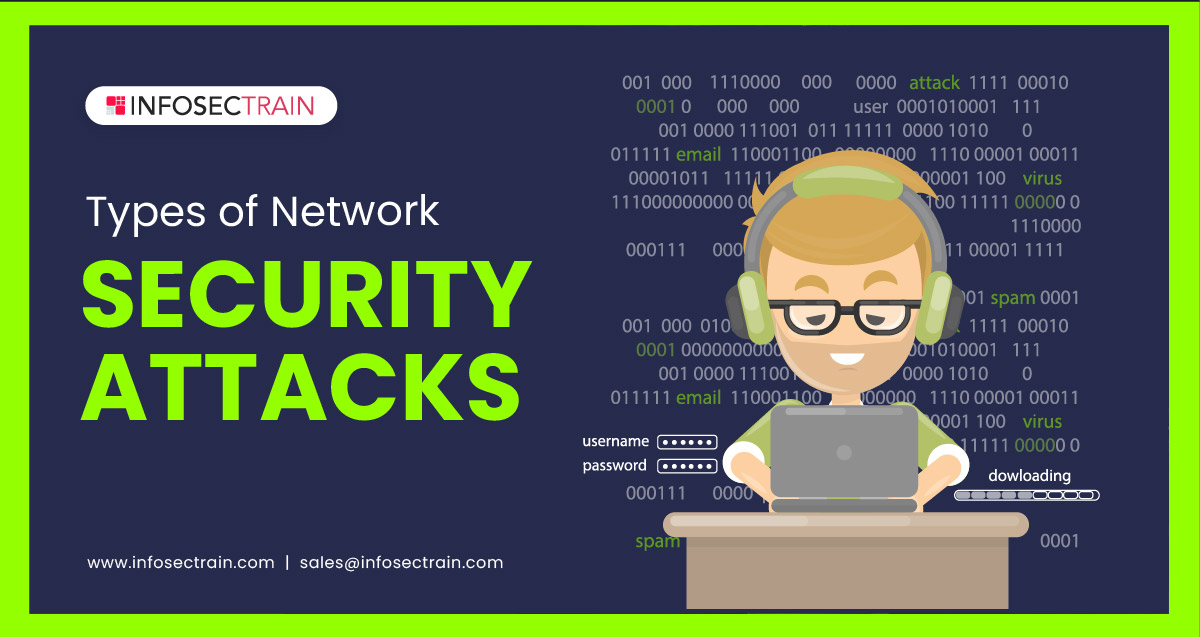Types of Network Security Attacks

Nowadays, every organization or business of all sizes relies on a computer network to store all their confidential and sensitive data online, accessible via the network. That is why they require Network Security to protect their data and infrastructure from hackers.
Table of Contents
What is Network Security?
Types of Network Security Attacks
So, in this article, we will look at what Network Security is and what types of Network Security Attacks there are.
What is Network Security?
Network Security protects data and systems from unauthorized access, unwanted modification, intrusions, and other threats because unauthorized persons or attackers can penetrate your data, expose personal information, or steal money. It defends network traffic and protects your infrastructure from numerous threats, including trojan horses, malware, etc.
Types of Network Security Attacks
There are different types of attacks on Network Security. We will discuss the most common types:
1. Malware: Malware is the fastest type of malicious software that a hacker designs specifically for his use to disrupt and damage systems and networks of systems and acquire authorized access to steal data or personal information. Malware is automatically installed via the internet and quickly infects all computers linked to the network.
2. Virus: A virus is also malicious software but requires user interaction to harm the system. The virus cannot replicate itself; it requires human involvement by using malicious links, such as email attachments that contain malicious code. Your files can be corrupted when you click on malicious links, and your personal information is stolen.
3. Worm: The most common standalone computer malware program is the worm, which replicates itself without human involvement and spreads via a network from one infected system to another by exploiting system flaws and transmitting “payloads” that harm host computers. Worms don’t need a host file to get started; they use the same host as the system they are in, and the number of worms grows over time. It penetrates the system via an application and consumes its processing power bandwidth, causing the system to become unresponsive.
4. Man-in-the-middle: A Man-in-the-middle (MITM) attack occurs when an attacker stands between two devices or between a client and a server, intercepts, monitors, and steals confidential data, or modifies it and sends it back to the original receiver.
5. Distributed Denial of Service (DDoS): DDoS (Distributed Denial of Service) is a more sophisticated type of DoS attack. In this attack, the attacker uses numerous systems to bombard the victim’s server with traffic, causing the server or network to malfunction and the victim to be unable to access it. It is challenging to detect DDoS threats since they are launched from several infected systems. Most black hat hackers use this attack to blackmail or retaliate against the victim.
There are three types of denial-of-service attacks:
- Connection flooding
- Vulnerability attacks
- Bandwidth flooding
6. Phishing: A phishing attack is a social engineering attack. An attacker manipulates the victim’s thoughts to get personal information like credit and debit cards, online banking details, username and password, social networking information, and other digital account information. Phishing is the term used nowadays when a hacker or attacker tries to deceive individuals by threatening, frightening, or seducing them. Attackers send malicious attachments and links to users via email, posing as trusted sources such as company owners, managers, or bankers. When users open the email with interest, they allow access to the attackers.
7. IP Spoofing: IP (Internet Protocol) Spoofing is a form of malicious attack. Spoofing is a DDoS and Man-in-the-Middle attack technique used by attackers on target devices. The attacker keeps track of the system’s packet header information, such as IP address and Mac address, and then replaces the source IP address with a spoofed IP address to impersonate the sender’s true identity. The receiver will believe it interacts with a trusted source and provides access to the attacker. Hackers take advantage of spoofed IP packets because they know these are the primary way of transmitting data between sender and recipient.
8. Botnet: Botnets are a group of computers and networks, including PCs, servers, and mobile devices, infected with malware and controlled by hackers. A hacker uses malicious software to connect with multiple computers via a private network to perform attacks. Because it attacks various systems at once and corrupts them, this attack is also known as the zombie army attack. Without the owner’s awareness, the attacker gains access to and manages all of the systems on that network, manipulates bots to transmit spam, steal data, and gain unwanted access.
9. Trojan horse: A Trojan horse is a malicious application that seems useful due to its harmless appearance, but it is harmful when installed and downloaded on a computer. This is a malicious program that can alter computer settings and perform unusual tasks like deleting file allocation tables and causing the system to hang. It is usually embedded in games and spreads via social engineering methods like emails. It could give attackers access to personal information such as financial information, usernames, passwords, etc.
10. Packet Sniffer: Packet sniffers capture or save copies of each transmission packet when packets flow over a network in a wireless transmission zone. A sniffer is a tool attackers use to gather sensitive information such as social information, financial data, trade secrets, user IDs, passwords, etc. Sniffing is a data theft technique that involves capturing, decoding, inspecting, and interpreting the information contained within a network packet on a TCP/IP connection using a packet sniffer.
Network Security with InfosecTrain
If you want to increase your basic network and network security knowledge, connect with InfosecTrain. InfosecTrain delivers a Network Security training course to teach you how to learn network administration and security techniques and also how to recognize and prevent numerous types of network security threats and attacks.




 1800-843-7890 (India)
1800-843-7890 (India) 
